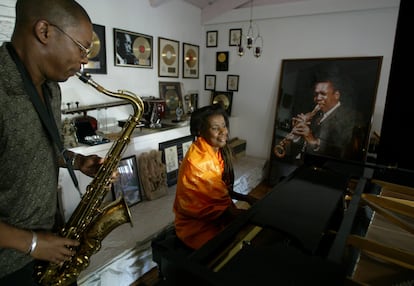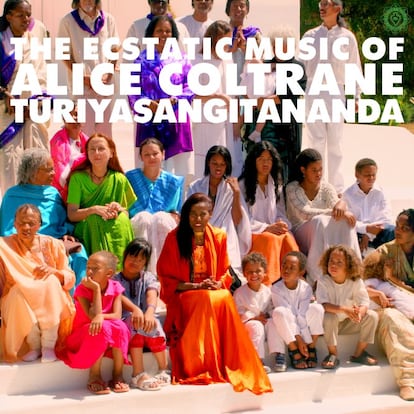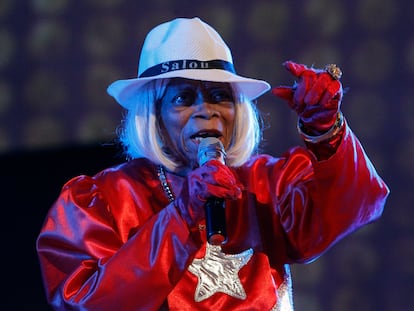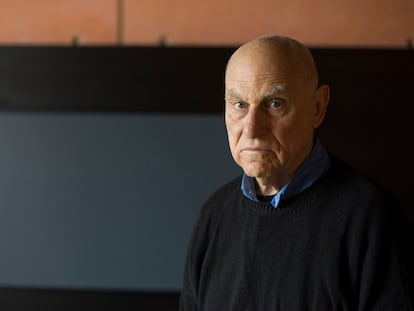Alice Coltrane: The enlightenment and rage of the great master of spiritual jazz
A recording of a previously unreleased concert by the pianist at Carnegie Hall, made at the time when she found her sound, marks the beginning of a year filled with tributes to the widow of John Coltrane

Saxophonist Ravi Coltrane, son of jazz legends John and Alice Coltrane, remembers that Hindu spiritual leader Satchidananda Saraswati was a constant presence in their family home on Long Island, New York. He also remembers that they used to keep horses and that Satchidananda “jumped right on their backs without a saddle”; such was his “powerful connection with people and animals.” At that point, for some reason that escapes him more than half a century later, he preferred to be called Paul, not Ravi.
The guru was a great support for his mother after saxophonist John Coltrane, one of the great musicians of the 20th century, died in 1967 at the age of 40. Alice suddenly found herself a 29-year-old widow with four small children, three of her own and one from her husband’s previous relationship. “All my life, I have to live without him, though I know it is his invisible hand that has brought me through,” she said in an interview with Ebony magazine. In her memoir Monument Eternal, she talks about what followed next: sleepless nights, hallucinations and meditating up to 20 hours a day. She lost 15 kilos while in mourning, not only for her husband; but also for her “spiritual companion” and the musician in whose quintet she played in the last two years of the saxophonist’s brilliant career.
Luckily, grief did not prevent Alice from finding her own sound: devotional and enigmatic music with traces of blues. She began playing the harp, a gift from John, and the technique she developed with the instrument influenced her way of approaching the piano, says her son Ravi, 58, a jazz star in his own right. “She translated the glissandos into a sort of cascading sound,” he says in a video interview from San Francisco.
It is enough to read the critics of the time to understand that not everyone took the widow of the great musician seriously. She had to contend with the shadow of John Coltrane’s gigantic legacy, and worse still, to do so in a man’s world. “When women instrumentalists have garnered attention for their talents in the male-dominated jazz world, their success has usually hinged on the supposedly male qualities of their playing: they are praised for their strong rhythm, big sound, and aggressive improvisations,” writes Franya J. Berkman in her biography of the artist. “Critics who expected to find the aggressive intensity that characterized her work with John Coltrane’s ensemble were frequently disappointed.”

Her work received a warmer reception over the years, before coming to the fore in the last decade thanks to the discovery of her lesser-known albums and tributes from rock bands (Radiohead), hip-hop artists and electronic musicians (Flying Lotus, who is also her nephew). The sign of the times seems to be blowing in her favor: Alice Coltrane (with the rest of what they label spiritual jazz) fits into some of the currents that define the present, from Afrofuturism to the search for spiritual alternatives in a fractured world. The de-hierarchized narrative fostered by new forms of music consumption has also helped, and according to Ravi, this has allowed her to better connect with younger generations than other icons of the genre
Alice Coltrane’s career took a big leap forward with her fourth album, Journey in Satchidananda, a masterpiece with a timeless sound that is dedicated to the guru who introduced her to music and Eastern religions. The Hindu tradition, she later explained, was the one that best adapted to the search for a universalist spirituality that also defined her last years with John Coltrane. Once the recording was finished in December 1970, she left with Satchidananda on a five-week trip to India: she swam in the Ganges, visited monasteries in the Himalayas and made a pilgrimage to the Taj Mahal.
In February, a week after the album’s release, Alice Coltrane recruited two saxophonists (Pharoah Sanders and Archie Shepp, notable disciples of John Coltrane), two double bassists (Jimmy Garrison and Cecil McBee), two drummers (Ed Blackwell and Clifford Jarvis), two tambura payers (Kumar Kramer) and harmonium player (Tulsi Reynolds) to play two songs from Journey in Satchidananda and two compositions from her husband’s repertoire at New York’s Carnegie Hall in New York. The group was not meant to play for more than the 20 minutes that was agreed to, but they ended up performing for close to 80.
The lost tapes
Her producer at the time, Ed Michel, recorded the concert with a view of releasing it. But that record never eventuated, because the heads of Impulse! — a label in which John Coltrane had been active since 1961 — thought that it would not be commercially viable. That disdain, Michel writes in the new album’s booklet, hid something else: if they kept it in the catalog it was because Alice Coltrane held the keys to the saxophonist’s legacy. Last March 22, after 53 years, the music of that night — which was partially released in pirated editions — finally saw the light of day. The music is a reconstruction based on the recording of two tracks that Michel kept as a souvenir. The original four-track tapes were lost: one was in the family archive, and the other was kept by the record company, whose ownership changed hands over the years (today it belongs to Universal).
The rescue of The Carnegie Hall Concert is important not only because no live recordings have been preserved from that decisive period in Alice Coltrane’s career, but because in the second part of the concert, the long performances of Leo and Africa proved that that band also knew how to sound angry and present the pianist as something more than the beatific caricature to which she and by extension spiritual jazz are often reduced.
The goal of the evening was to raise funds for the Indian guru. Singer-songwriter Laura Nyro and the rock band The Rascals. The group’s leader Felix Cavaliere, was, like Nyro, a disciple of Satchidananda. For Satchidananda, who left his career as a businessman and embraced religion after the death of his wife, it was not his first collision with pop culture: the swami (teacher) arrived in the United States in 1966 and famously opened the Woodstock festival with a blessing. At the 1971 Carnegie Hall concert, $8,000 — the equivalent of $61,000 today — was raised for Satchidananda’s yoga institute, which, amid the rise of the new age, went from having one center in New York to 25 throughout the country between 1970 and 1972. That year, as writer Lauren Graf points out in The Carnegie Hall Concert album booklet, Satchidananda was involved in the first of a series of scandals “for his [inappropriate] relationships with his students.” “A guru who, like many others, proved to be all too human,” Graf concludes.
A couple of weeks ago, McBee, one of the two double bassists who played at Carnegie Hall, recalled the concert from his New York apartment in a video conference with EL PAÍS, describing it as “rather demanding.” He never knew they had recorded it until he was recently contacted by the label. “Thank goodness, because then I was a young man finding my way in New York and I think I would have been nervous.” In the years that followed, McBee would become one of the most interesting composers in avant-garde jazz and also one of the most sought-after accompanists on the scene.
“Alice was a very quiet, introspective type of person,” explains the double bassist, who is still active at 88 years old. “She left you a lot of freedom, and I trusted that you knew how to make decisions that went beyond what was expected. She rarely spoke to you, and if she did, it was mostly only about music.” One of those rare occasions was on the recording of Journey in Satchidananda, when the pianist dictated the infectious 3x4 melodic bass line that opens the album.
“They were both very introspective and intuitive,” Ravi Coltrane says of his parents. “That’s why they understood each other so well. And I think they influenced each other a lot. I have never met anyone like my mother. It’s not easy to describe the type of person she was,” adds the musician, who was not even two years old when his father died.

McBee first encountered the pianist during his years in Detroit, where she was born in 1937. In the early 1960s, she was still called Alice McLeod and performed bebop. She grew up playing the organ in church, went to study in Paris for a while, and upon returning to the United States he was in vibraphonist Terry Gibbs’ band. In New York, she met John Coltrane. They married in 1965 and soon she joined the saxophonist’s new and revolutionary quintet, along with Jimmy Garrison, the old double bassist, and two other young men: the recently deceased Pharoah Sanders and drummer Rashied Ali. None of the them had it easy with the leader’s legion of fans: they were blamed for John Coltrane’s decision to leave behind his classic quartet and with it, a certain orthodoxy. But Alice Coltrane got the worst of it, both before and after his death, when she was left with the power over which unreleased recordings would see the light of day and in what form.

Increasingly distant from jazz, Alice Coltrane moved with her family to Los Angeles in 1972, where she achieved the rank of swamini, and abandoned her secular name for Turiya, an abbreviation of Turiyasangitananda (in Sanskrit: “the highest song of bliss of the Transcendental Lord”). She also changed labels (to Warner) and even recorded an album with Santana, Iluminations (1974). She founded a Vedic school in her home, and in the early 1980s, a monastery (ashram) in the Santa Monica Mountains. By then, she had retired from public life, but, concentrating on two new instruments, her voice and synthesizers, she never stopped making music, nor did she stop recording it and publishing it on cassettes that were sold in the ashram. Yoga teacher Purusha Hickson, one of her first disciples, recalled in a conversation with EL PAÍS the impact of hearing her sing for the first time one of those tapes: “Her voice was very powerful. She would tell us that it was simply God manifesting through her body. She was the great reference point in my life.”
In 2004, her son Ravi convinced her to record one last jazz-tinged album. In 2007, she died in Los Angeles. She was 69 years old.

On the 10th anniversary of her death, Luaka Bop — a label founded by David Byrne — successfully released a compilation of songs from those hard-to-find cassettes, which in turn has led to greater appreciation of the artist’s devotional music. A couple of years ago, Impulse! released for the first time, one of those tapes on CD and vinyl, Turiya Sings (1982). Ravi explains the renewed interest in his mother by saying that the world finally understood what she wanted to express. “She didn’t play music to be recognized or to become famous or to have critics write positive reviews. She believed that creativity was like a gift that you shared, it was not something that completely belonged to you. It is a very special music, and everyone has an opportunity to come to the music in their own time. As time goes, by more and more people will discover her music.” McBee, for his part, believes that the albums they made in the 1970s “are better understood now than they were then.”
The release of The Carnegie Hall Concert is the first milestone in what her three living children have dubbed “The Alice Year.” “We thought that it would be really nice before that big year of 2026 [the centenary of John Coltrane’s birth] to acknowledge Alice and her work,” says Ravi. These tributes include the reissuing of old albums in new formats, the release more unpublished recordings, the launch an “oral history” project about Alice Coltrane, a ballet by choreographer Alonzo King based on her music, an exhibition of contemporary artists in Los Angeles and the restoration of the harp that John bought her shortly before he died.
The instrument took several months to arrive, and when it finally did, the saxophonist had died. In her memoirs, Alice Coltrane recalls that when the windows of her Long Island home were open, the wind sometimes played its strings. As if an “invisible force” was strumming them.
Sign up for our weekly newsletter to get more English-language news coverage from EL PAÍS USA Edition
Tu suscripción se está usando en otro dispositivo
¿Quieres añadir otro usuario a tu suscripción?
Si continúas leyendo en este dispositivo, no se podrá leer en el otro.
FlechaTu suscripción se está usando en otro dispositivo y solo puedes acceder a EL PAÍS desde un dispositivo a la vez.
Si quieres compartir tu cuenta, cambia tu suscripción a la modalidad Premium, así podrás añadir otro usuario. Cada uno accederá con su propia cuenta de email, lo que os permitirá personalizar vuestra experiencia en EL PAÍS.
¿Tienes una suscripción de empresa? Accede aquí para contratar más cuentas.
En el caso de no saber quién está usando tu cuenta, te recomendamos cambiar tu contraseña aquí.
Si decides continuar compartiendo tu cuenta, este mensaje se mostrará en tu dispositivo y en el de la otra persona que está usando tu cuenta de forma indefinida, afectando a tu experiencia de lectura. Puedes consultar aquí los términos y condiciones de la suscripción digital.
More information
Archived In
Últimas noticias
Welcome to the post-religion era: The idea of Christianity as the absolute truth has become obsolete
‘I thought you would like it’: The risky sexual practice popularized by TV shows and TikTok
The digitalization of tourism: ‘They promise experiences and gave us the worst possible one’
Mexican peso defies uncertainty with forecasts of a new period of stability in 2026
Most viewed
- Sinaloa Cartel war is taking its toll on Los Chapitos
- Reinhard Genzel, Nobel laureate in physics: ‘One-minute videos will never give you the truth’
- Oona Chaplin: ‘I told James Cameron that I was living in a treehouse and starting a permaculture project with a friend’
- Why the price of coffee has skyrocketed: from Brazilian plantations to specialty coffee houses
- Silver prices are going crazy: This is what’s fueling the rally










































